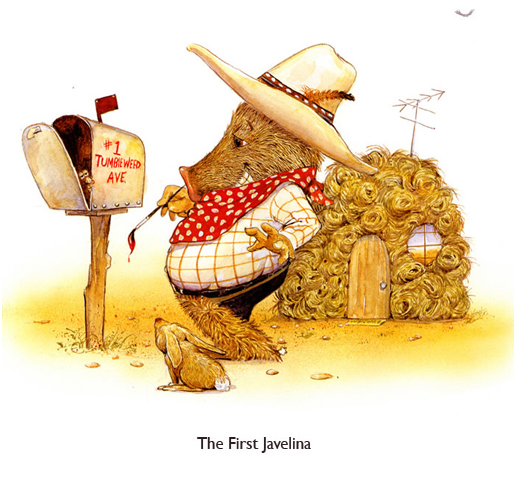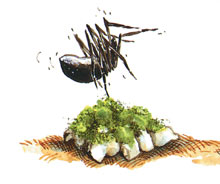1. BIBLIOGRAPHY
Lowell, Susan. The Three Little Javelinas. Hong Kong: Northland Publishing, 1992. ISBN 0-87358-542-9
2. PLOT SUMMARY
In this wonderful, southwestern adaptation of The Three Little Pigs, three javelinas part ways as they set out on a journey to find their fortunes. The first brother builds a house out of tumbleweed, and the second builds one out of sticks, but both get blown away by a hungry, tricky coyote who wants to enjoy them for dinner. The third javelina, the sister, build herself an adobe house and is soon joined by her brothers who have managed to scape the coyote. Her sturdy house is the only one to withstand the huffs and puffs of the coyote, even when he tries to "use his magic" to attempt going down the stovepipe, and he learns a lesson he will never forget. An the javelinas lived happily ever after.
In this wonderful, southwestern adaptation of The Three Little Pigs, three javelinas part ways as they set out on a journey to find their fortunes. The first brother builds a house out of tumbleweed, and the second builds one out of sticks, but both get blown away by a hungry, tricky coyote who wants to enjoy them for dinner. The third javelina, the sister, build herself an adobe house and is soon joined by her brothers who have managed to scape the coyote. Her sturdy house is the only one to withstand the huffs and puffs of the coyote, even when he tries to "use his magic" to attempt going down the stovepipe, and he learns a lesson he will never forget. An the javelinas lived happily ever after.
3. CRITICAL ANALYSIS
This tale starts and ends like most traditional tales often start, with "Once upon a time" and "lived happily ever after". It is a fun book to read aloud, not only because it is a variant of the familiar The Three Little Pigs, but also because of the repetition of the language between the characters - the coyote politely asks "little pig, little pig, let me in", and continually gets the same response, "not by the hair of my chinnny-chin-chin".
The Three Little Javelinas features fables told by southwestern Indians, where coyote is a trickster who is outsmarted by other animals. It takes place in the Sonoran Desert, where the three javelinas encounter dust storms ad extremely hot weather, with mentions of snakes and hawks floating above. In addition, the javelinas' houses fit with the theme because the Tohono O'Odham traditionally built temporary and permanent homes out of brush, sticks, mud and ramadas, as it is mentioned in the note upon completion of the story. Harris' illustrations support the southwestern theme, down to the last, little detail and showcase the javelinas wearing cowboy attire.
This tale of good and bad, shares a notion with readers that the good guys always win in the end. The javelinas were hard workers, who were following their dreams, when the "bad" coyote came along to ruin their plans. I personally enjoyed the female protagonist having the best outcome, not only because she was successful in her journey, but also because she was able to help her siblings and teach coyote a lesson.
4. REVIEW EXCERPT(S)
From Publishers Weekly: "This clever and flavorful change of scene puts a diverting spin on an old favorite.”
From Booklist: “Harris' illustrations are appealing and humorous, and children who loved the original will enjoy this version.”
From School Library Journal: "Whether read aloud or in amused solitude, this is a picture book that will be enjoyed again and again."
Arizona Young Readers Award 1994
Washington Children’s Choice Picture Book Award Finalist
5. CONNECTIONS
From School Library Journal: "Whether read aloud or in amused solitude, this is a picture book that will be enjoyed again and again."
Arizona Young Readers Award 1994
Washington Children’s Choice Picture Book Award Finalist
5. CONNECTIONS
Gather other variants of the Three Little Pigs read such as:
• The Three Little Gators ISBN 080757824X
• The Three Little Pigs and the Somewhat Bad Wolf. ISBN 0439915015
Gather other Susan Lowell books to read such as:
• Dusty Locks and the Three Bears. ISBN 0805075348
• Cindy Ellen: A Wild Western Cinderella. ISBN 0064438643
• The Tortoise and the Jackrabbit (Avenues). ISBN 0873585860
Lesson Ideas:
Compare and contrast the different variants of the Three Little Pigs
Use to learn about the Javelinas' habitat (desert)







